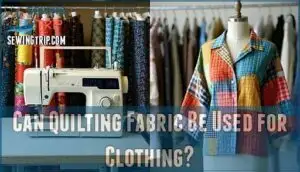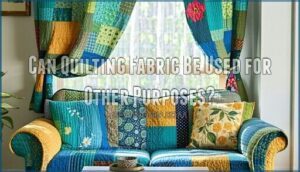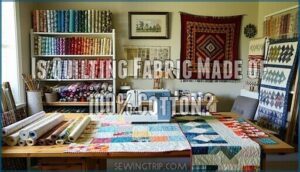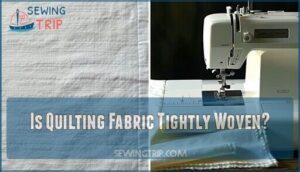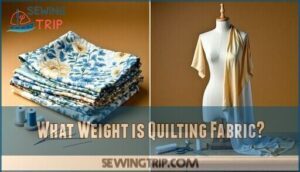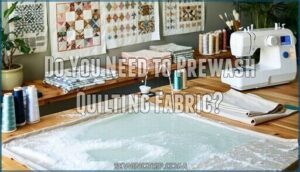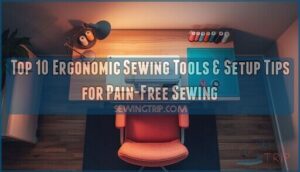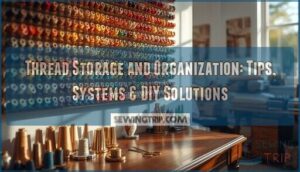This site is supported by our readers. We may earn a commission, at no cost to you, if you purchase through links.
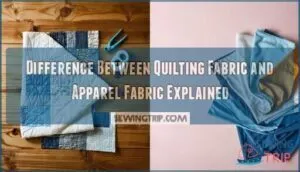
Quilting fabric is usually 100% cotton, tightly woven, and made to hold its shape—think of it as the reliable workhorse for patchwork and crafts.
Apparel fabric, though, comes in all sorts of fibers, weights, and textures, from soft jersey for T-shirts to flowy rayon for dresses.
It’s built for comfort and movement, hugging your body instead of sitting flat. If you’ve ever tried wearing a stiff quilt, you’ll know why this matters.
Curious how these fabrics handle other projects? There’s more to uncover.
Table Of Contents
- Key Takeaways
- What is Quilting Fabric?
- Characteristics of Quilting Fabric
- Can Quilting Fabric Be Used for Clothing?
- Using Quilting Fabric for Apparel
- Differences Between Quilting Fabric and Apparel Fabric
- Can Quilting Fabric Be Used for Other Purposes?
- Is Quilting Fabric Made of 100% Cotton?
- Is Quilting Fabric Tightly Woven?
- What Weight is Quilting Fabric?
- Do You Need to Prewash Quilting Fabric?
- Frequently Asked Questions (FAQs)
- Conclusion
Key Takeaways
- You’ll find quilting fabric is almost always 100% cotton, tightly woven, and medium-weight, giving it structure and durability for projects that need to hold their shape.
- Apparel fabric comes in a wide range of fibers, weaves, and weights, so it’s designed for comfort and drape, and movement—making it ideal for clothing.
- Quilting fabric resists stretching and fraying, but it feels stiffer and creates boxier garments, while apparel fabric offers more flexibility and fits the body better.
- You should prewash quilting fabric to prevent shrinkage and color bleeding, and expect it to be more colorfast and vibrant than most apparel fabrics.
What is Quilting Fabric?
Quilting fabric serves as your go-to material for creating durable, long-lasting projects that need structure and stability.
This fabric composition consists of 100% cotton with a plain weave type, making it ideal for beginners who want reliable results.
The fabric weight ranges from 4.5 to 5.5 ounces per square yard, giving you that perfect medium-weight feel that’s neither too flimsy nor too heavy.
Quilting cotton features a tight fabric weave that prevents fraying and maintains shape through countless washes.
You’ll find fabric characteristics include minimal stretch, crisp texture, and excellent print styles ranging from tiny florals to bold geometrics.
The weight range makes it perfect for common uses like quilts, home décor items, and structured garments.
However, you’ll need to prewash this cotton to prevent shrinkage and color bleeding, and keep your iron handy since it wrinkles easily.
Characteristics of Quilting Fabric
Looking at what makes quilting fabric unique reveals several key properties that distinguish it from other materials. Understanding these characteristics helps you choose the right fabric for your projects.
Fiber Content and Construction
Quilting fabric is almost always 100% cotton with a plain weave structure. This combination creates a stable foundation that resists stretching and maintains its shape through repeated washing and handling. The plain weave also prevents excessive raveling during cutting and piecing.
Weight and Durability Features
Most quilting cotton falls within a specific weight range of 4.5 to 5.5 ounces per square yard, making it substantially heavier than typical apparel fabrics. This medium weight provides the perfect balance between workability and durability for quilting projects.
Key Performance Characteristics:
- Thread Count: Averages 60-68 threads per inch, creating a tighter weave than many apparel fabrics
- Shrinkage Rate: Typically 3-5% in both directions, requiring prewashing for accurate measurements
- Print Scale: Often features smaller-scale designs optimized for quilt block piecing
The fabric’s tendency to wrinkle comes from the cotton fibers and plain weave structure, but this same characteristic helps create crisp seams and precise piecing in quilting projects. Selecting long staple cotton enhances quilt softness.
Can Quilting Fabric Be Used for Clothing?
Yes, you can use quilting fabric for clothing, though it has limitations. Quilting cotton works well for structured garments like shirts and children’s wear but lacks the drape needed for flowy pieces. Its stiff nature creates boxy silhouettes rather than form-fitting styles.
One should also consider that quilting cotton, available from various manufacturers, can differ in thread count and feel.
| Clothing Type | Quilting Fabric Suitability |
|---|---|
| Button-up shirts | Good – structure works well |
| Flowing dresses | Poor – too stiff, no drape |
| Children’s pajamas | Excellent – durable, fun prints |
| Fitted blouses | Limited – creates boxy shape |
| Casual skirts | Good – holds shape nicely |
While quilting fabric offers clothing durability and garment structure, comfort factors suffer compared to dedicated apparel fabric. Design limitations include reduced drape and potential stiffness. Consider fabric alternatives like cotton lawn or voile for garments requiring movement and comfort.
Using Quilting Fabric for Apparel
Fashion-forward sewists can transform quilting cotton into stunning clothing pieces with proper planning.
Turn crisp quilting cotton into standout shirts and skirts with a little creativity and the right sewing tricks.
Quilting fabric offers excellent garment suitability for structured items like button-down shirts and A-line skirts. However, drape challenges arise with flowing designs due to the fabric’s crisp nature.
The smaller print scale typical of quilting cotton creates interesting visual texture in clothing. Durability concerns are minimal since quilting fabric withstands frequent washing.
Note that fabric width matters, as most quilting cotton is narrower than apparel fabric.
Essential sewing techniques include prewashing to prevent shrinkage and using appropriate needles for the medium-weight cotton.
Differences Between Quilting Fabric and Apparel Fabric
When you’re choosing fabric for your next project, understanding the key differences between quilting and apparel fabrics will help you make the right choice.
While both are often made from cotton, they’re designed for different purposes and have distinct characteristics that affect how they perform.
Weave and Texture
Understanding fabric weave and texture helps you choose the right material for your projects.
Quilting fabric uses a plain weave structure, creating a simple crisscross pattern that produces a smooth, flat surface.
This weave type offers excellent stability and minimal stretch, making it perfect for precise piecing work.
Apparel fabric showcases much greater texture variety.
You’ll find twill weaves with diagonal lines, satin weaves with lustrous surfaces, and specialty weaves like crepe or jacquard.
These weave types create different fabric hand characteristics – from silky and drape-friendly to textured and structured.
Exploring different textiles reveals the nuances of apparel fabric textures.
The surface interest varies substantially between these fabric categories.
Quilting fabric maintains a matte appearance that highlights printed patterns clearly.
Apparel fabric ranges from glossy finishes to raised textures, offering enhanced visual appeal for garments.
When selecting fabric weave, consider your project’s needs.
Plain weave quilting fabric excels in structured applications, while varied apparel fabric weaves provide the flexibility and comfort essential for clothing construction.
Weight and Drape
Fabric weight and drape work together to determine how your material behaves.
Quilting fabric typically weighs 140-160 GSM, creating a stiffer, more structured feel that holds its shape rather than flowing.
Apparel fabric offers much more variety – lightweight cottons like voile weigh under 150 GSM and drape beautifully for summer dresses, while medium-weight options work well for shirts.
This drape comparison shows why quilting fabric suits structured garments but struggles with flowing styles.
Many resources discuss quilting fabric weights in detail.
Project requirements should guide your choice: quilting fabric for durability, apparel fabric for comfort and movement in seasonal fabrics.
Stretch and Comfort
Someone can feel the difference between quilting fabric and apparel fabric the moment they touch them. Quilting fabric’s plain weave creates a stable structure with minimal stretch, while apparel fabric often incorporates elastane or knit constructions for flexibility.
This fabric comparison reveals substantial comfort factors that affect garment suitability. Key stretch and comfort differences:
- Stretch capability – Quilting fabric offers virtually 0% stretch along the grain, while apparel fabric can stretch 40-100% depending on fiber content and weave impact.
- Body movement – Quilting fabric’s tight weave restricts movement, making garments feel boxy. Apparel fabric’s stretch accommodates natural body motion for all-day comfort.
- Recovery properties – Quilting fabric won’t return to original shape after stretching, while stretch apparel fabrics maintain their form through repeated wear and washing.
The fabric drape also differs substantially. Quilting fabric’s stability makes it ideal for structured garments, but apparel fabric’s flexibility provides the comfort and fit most clothing requires.
Appearance and Style
Your quilting fabric projects will have a distinctly different look compared to apparel fabric creations.
Quilting fabric’s print scale tends to be smaller and more intricate, with vibrant colors that hold up through countless washes.
You’ll notice pattern complexity ranges from simple geometrics to detailed florals, but the fabric texture remains consistently smooth and flat.
Apparel fabric offers broader visual appeal through varied weaves – from silky satins to textured tweeds.
The aesthetic differences are clear: quilting fabric creates structured, crisp-looking garments while apparel fabric provides sophisticated drape and fabric design versatility for refined clothing styles, with a focus on refined clothing.
Can Quilting Fabric Be Used for Other Purposes?
You don’t need to limit quilting fabric to just quilts—it works well for many home décor projects too.
Its sturdy cotton construction and vibrant prints make it perfect for curtains, upholstery, and cushions where you want durability and style.
Curtains
You’ll love how quilting fabric transforms your windows into stunning focal points.
The medium-weight cotton provides excellent fabric durability while offering countless curtain styles to match your decor.
Unlike lightweight apparel fabric, quilting cotton holds its shape beautifully when hanging.
Here’s what makes quilting fabric perfect for curtains:
- Light blocking capabilities – The tighter weave provides better coverage than thin fabric types
- Thermal properties – Cotton’s natural insulation helps regulate room temperature
- Easy maintenance – Withstands frequent washing without losing color or shape
While quilting fabric works wonderfully for decorative curtains, you might need curtain linings for complete light blocking.
You can find numerous options for quilting fabric curtains online.
The 44-inch width means you’ll likely need multiple panels for wider windows, but the vibrant patterns and durability make it worth the effort.
Upholstery
Old chairs and sofas can get a second chance with the right fabric.
Quilting fabric, while not as tough as standard upholstery, can work for light-use furniture if you reinforce it with backing.
Think about fabric durability and pattern suitability—bold prints bring life to a room, but may fade with heavy use.
Cleaning methods matter, too: cotton needs quick attention to spills.
For cost analysis, quilting cotton is often cheaper than specialty upholstery fabric.
Style considerations are endless, letting you match your décor without breaking the bank.
Choose wisely for lasting results.
Cushions
In the context of cushions, quilting cotton stands out for Cushion Durability and easy fabric use compared to apparel fabric.
It holds up well, but isn’t as tough as heavy-duty upholstery.
For cushions, think about:
- Cushion Filling—choose firm or soft based on use.
- Cushion Shapes—square, round, or custom.
- Cushion Styles—modern, classic, or playful.
- Cushion Cost—quilting fabric is affordable, but may need more frequent washing.
Is Quilting Fabric Made of 100% Cotton?
Most quilting fabric you’ll find is 100% cotton, prized for its comfort, breathability, and easy sewing.
Still, cotton alternatives and blends exist, offering fiber variations for unique looks or performance. While quilting cotton is the gold standard, material impact and print compatibility can shift with blends.
Always check labels, as not all fabric is pure cotton. If you’re after durability, softness, and vivid prints, stick to 100 cotton quilting fabric.
- Soft and gentle on skin
- Easy to sew and manage
- Holds vibrant colors well
- Reliable for lasting projects
Is Quilting Fabric Tightly Woven?
Most folks are surprised by how tightly woven quilting fabric is.
Thanks to its plain weave, quilting cotton boasts high weave density and thread count, which adds to fabric stability and durability factors.
This tight structure means it holds up well to frequent washing and handling.
You’ll also notice print quality is crisp, thanks to the dense weave.
Compared to many apparel fabrics, quilting fabric resists fraying and stretching, making it a sturdy choice when you need your project to last.
What Weight is Quilting Fabric?
When you’re picking fabric for your next project, pay close attention to fabric weight impact.
Quilting fabric, especially quilting cotton, usually falls into the ideal weight range of 140–150 GSM—medium weight.
This gives your quilt structure and durability, making it perfect for piecing.
Apparel fabric, on the other hand, comes in many fabric weight variations, from airy voile to sturdy denim.
Remember, weight vs. drape matters: quilting weight uses give stability, but too much weight can make clothes feel stiff or bulky.
Do You Need to Prewash Quilting Fabric?
If you’ve just learned about the weight of quilting fabric, here’s another step you shouldn’t skip—prewashing.
Prewash quilting cotton before you cut or sew. This helps with shrinkage prevention and keeps your final project from ending up smaller than planned.
Prewashing also washes out excess dye, lowering the risk of color bleeding onto lighter fabrics. As a key step, consider preventing fraying techniques before washing.
Use lukewarm water and a gentle detergent to keep fabric softness and avoid harsh chemicals that could stiffen the cloth.
After washing, press the fabric while it’s still damp to help with weave distortion and set the dye. Let it dry flat for best results.
Taking time to prewash quilting fabric guarantees your colors stay bright, your seams stay straight, and your project lasts.
Frequently Asked Questions (FAQs)
What is the difference between apparel fabric and quilting fabric?
Picture two roads diverging: quilting fabric is sturdy, medium-weight cotton with a tight weave, made for structure and repeated washing.
Apparel fabric offers more drape, softer textures, and comes in many fibers for comfort and style, which can be considered as having a different purpose than quilting fabric, focusing on comfort.
What makes quilting fabric different?
Quilting fabric stands out because it’s medium-weight, tightly woven, and usually 100% cotton.
You’ll notice it holds its shape, resists stretching, and comes in endless prints—perfect for projects needing strength, stability, and lasting color.
What is the difference between apparel and fabric?
Think of fabric as the canvas and apparel as the finished painting.
You use fabric to make things, but apparel is fabric shaped into clothes.
Apparel fabric is made for comfort and drape, fabric is the raw material.
How does quilting fabric handle repeated washing cycles?
You’ll find quilting fabric stands up well to repeated washing.
Its tight weave and higher thread count help it keep its shape and color.
Just remember to prewash before sewing, since cotton can still shrink a bit.
Are quilting fabrics more colorfast than apparel fabrics?
Like a VHS tape that refuses to fade, you’ll notice quilting fabrics are generally more colorfast than apparel fabrics.
They’re made to handle frequent washing, using high-quality, colorfast dyes that keep prints vibrant over time.
Can quilting fabric be dyed at home successfully?
You can dye quilting fabric at home, but you’ll want to prewash it first to remove finishes.
Use fiber-reactive dyes for best results, and always test a small piece to check for even color and shrinkage.
Is quilting fabric suitable for making reusable bags?
You can use quilting fabric to make reusable bags.
Its medium weight and durability hold up well for everyday use.
Just remember, it wrinkles easily, so a quick iron before sewing keeps your bags looking sharp.
How does quilting fabric pricing compare to apparel fabric?
You’ll usually pay more per yard for quilting fabric than for apparel fabric.
That’s because quilting fabric has a higher thread count, tighter weave, and specialty prints.
Still, apparel fabric often comes wider, giving you more fabric per yard.
Conclusion
Sometimes, choosing fabric is like picking the right tool for a job.
When you know the difference between quilting fabric and apparel fabric, you can avoid headaches and wasted effort.
Quilting fabric stays firm and keeps its shape, perfect for crafts and home projects.
Apparel fabric moves with you, making clothes comfortable and wearable.
Understanding these details helps you pick the right fabric every time, whether you’re sewing a quilt, a dress, or something new, using the right fabric for the right job, and making the process more enjoyable with apparel fabric.

